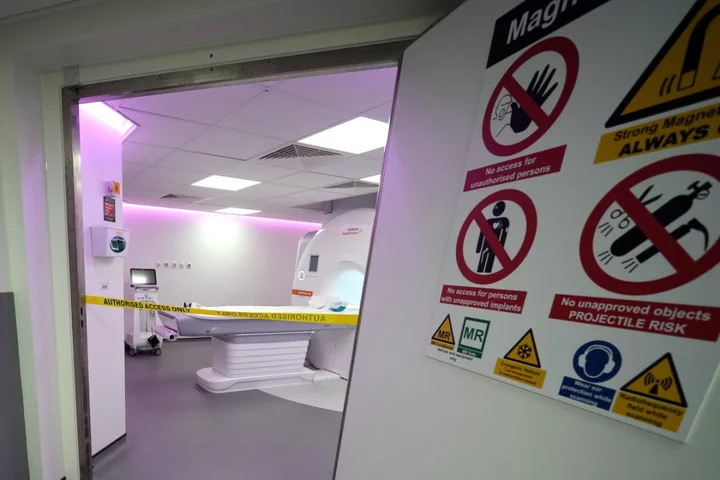
Brighton close on Carlos Baleba & open loan talks for Arsenal midfielder
Brighton near a €30m (£25.5m) deal for Lille midfielder Carlos Baleba as they bid to replace Moises Caicedo in central midfield.
1970-01-01 08:00

Thai parliament picks Srettha Thavisin as next prime minister ending 3 months of political deadlock
Thailand's parliament on Tuesday voted for real estate tycoon Srettha Thavisin to be the country's next prime minister, ending a political deadlock more than three months after elections delivered a landslide to progressive parties over pro-military groups.
1970-01-01 08:00

Prostate screening ‘could save lives’ – the symptoms and risk factors you need to know
There are more than 47,000 men diagnosed with prostate cancer every year in England but new research says using MRI scans can reduce deaths caused by the disease. Current tests usually detect the level of the protein prostate-specific antigen (PSA) in the blood, but scientists say this has meant overdiagnosis and overtreatment of low-risk cancer. The Reimagine study, by University College London, University College London Hospitals NHS Foundation Trust and King’s College London, invited 303 men aged between 50 and 75 to have a screening MRI and a PSA test. Of those men, 48 (16%) had an MRI that indicated prostate cancer despite having a median PSA density – 32 of those had lower PSA levels than the current screening benchmark, meaning they would ordinarily not have been referred for investigation. After NHS assessment 29 were diagnosed with cancer that required treatment, and three were diagnosed with low-risk cancer with no need for treatment. Prof Caroline Moore, consultant surgeon at UCLH, chief investigator of the study and NIHR research professor, called the findings “sobering”. She said: “Our results give an early indication that MRI could offer a more reliable method of detecting potentially serious cancers early, with the added benefit that less than 1% of participants were ‘over-diagnosed’ with low-risk disease.” What is prostate cancer? Prostate cancer is the UK’s most common male cancer. It affects the prostate – a walnut-sized gland that sits beneath the bladder and surrounds the urethra in people born with male sex organs. Its main purpose is to help produce semen (the fluid that carries sperm). Prostate cancer can develop when cells in the prostate start to grow in an uncontrolled way. While some prostate cancers grow quickly and spread, others grow too slowly to cause any problems and therefore will never need any treatment. What are the risk factors “Prostate cancer is a disease we tend to see in older age groups (over-50s), but there are exceptions, as with any form of cancer,” said Dr Sanjay Mehta, GP at The London General Practice. According to Prostate Cancer UK black men are at a higher risk – one in four black men will get prostate cancer in their lifetime (compared to one in eight for other men). The risk increases after the age of 45. Family history is important too; your father or brother has had prostate cancer or your mother or sister has had breast cancer, your risk is higher. What are the symptoms? Often there aren’t any signs in the early stages, so be aware of your own risk factors and chat to your doctor if concerned. Prostate Cancer UK have an online risk checker you can use too. Mehta said to watch out for urinary symptoms and changes to how you urinate. “So frequency, where you need to go more often. Hesitancy, where you’re standing over the toilet bowl and a period of time will pass before you’re able to pass urine, and ‘dribbling’, where you’ve finished but find you’re still passing when you walk away. “These are common in older men anyway. But if it’s new for you, and you find you’re having to go more often at night, and you’re having hesitancy or urgency, see your doctor.” Other things to get checked include erectile dysfunction, blood in your urine, and any new and unexplained lower back pain. “Then there are general systemic symptoms, like lethargy, lack of appetite,” added Mehta. “Again, these things often happen anyway, but if it’s a change for you and it’s been happening for a couple of weeks, see your doctor.” How is prostate cancer diagnosed and treated? First, your doctor will chat through your symptoms and history with you. “The next step would involve an examination, including a rectal examination of the prostate,” said Mehta, before referral for further investigations. “I appreciate this can put some men off seeing their doctor but it is a very helpful way of assessing things”. After diagnosis, treatment depends on the stage of the cancer and what’s suitable for each individual, but it may include surgery or radiotherapy. Caught early, prostate cancer is generally very treatable. And even with advanced prostate cancer, treatments have come a long way. Read More Charity boss speaks out over ‘traumatic’ encounter with royal aide Ukraine war’s heaviest fight rages in east - follow live Keep fit to avoid heart rhythm disorder and stroke, study suggests How to give your home a proper summer sort out What you really need to do in autumn to keep your lawn in shape
1970-01-01 08:00

Sara Sharif: Community reeling after death of 10-year-old, local MP says
The body of Sara Sharif, aged 10, was found at her home in Woking, prompting a murder inquiry.
1970-01-01 08:00

Greece wildfires: Hospital evacuated as fire intensifies in Alexandroupolis
Dozens of patients are moved to safety as wildfires burn out of control near Alexandroupolis.
1970-01-01 08:00

Chelsea agree deal for New England Revolution goalkeeper
Chelsea have agreed a deal with New England Revolution for goalkeeper Djordje Petrovic. The Blues have agreed to pay $21m (£16.5m) for the 23-year-old and he is expected to serve as understudy to Robert Sanchez.
1970-01-01 08:00

Keep fit to avoid heart rhythm disorder and stroke, study suggests
Keeping fit could help you avoid heart rhythm disorder and stroke, new research suggests. The study of more than 15,000 people found that physical fitness is linked with a lower likelihood of developing both conditions. Atrial fibrillation – irregular and often fast heartbeat – is the most common heart rhythm disorder, affecting more than 40 million people worldwide. The findings indicate that keeping fit may help prevent atrial fibrillation and stroke Dr Shih-Hsien Sung Patients with the condition have a five-fold higher risk of stroke than their peers, experts suggest. Study author Dr Shih-Hsien Sung of the National Yang Ming Chiao Tung University, Taipei, Taiwan said: “This was a large study with an objective measurement of fitness and more than 11 years of follow up. “The findings indicate that keeping fit may help prevent atrial fibrillation and stroke.” The study examined whether fitness was related to the likelihood of developing atrial fibrillation. It included 15,450 people without atrial fibrillation who were referred for a treadmill test between 2003 and 2012. Fitness was assessed using a protocol where people are asked to walk faster and at a steeper grade in successive three-minute stages. Their fitness was calculated according to the rate of energy expended, which was expressed in metabolic equivalents (METs). Follow-ups looked at whether people developed atrial fibrillation, stroke, heart attacks, or whether they had died. During an average follow-up period of 137 months, 515 participants (3.3%) developed atrial fibrillation. Each one MET increase on the treadmill test was associated with an 8% lower risk of atrial fibrillation, 12% lower risk of stroke and 14% lower risk of major adverse cardiovascular events (MACE – a composite of stroke, myocardial infarction and death). People in the study were divided into three fitness levels according to METs achieved during the treadmill test. The levels were low (less than 8.57 METs), medium (8.57 to 10.72) and high (more than 10.72). According to the findings presented at the ESC Congress 2023 in Amsterdam, the probability of remaining free from atrial fibrillation over a five-year period was 97.1%, 98.4% and 98.4% in the low, medium and high fitness groups, respectively. Read More Charity boss speaks out over ‘traumatic’ encounter with royal aide Ukraine war’s heaviest fight rages in east - follow live How to give your home a proper summer sort out What you really need to do in autumn to keep your lawn in shape MRI screening for prostate cancer could help save lives, study finds
1970-01-01 08:00

Astronomers are expecting a message from aliens today that is 40 years in the making
Astronomers are hoping to receive a message from aliens after a 40-year wait for a reply comes to an end. On 15 August 1983, a pair of hopeful astronomers at Stanford University beamed a message into space via an antenna. They believe that 22 August 2023 is the earliest time they can expect to receive a reply. The experiment was the brain-child of professors Masaki Morimoto and Hisashi Hirabayashi, who, around 40 years ago, beamed 13 drawings in radio waves to a star named Altair, approximately 16.7 light-years away from Earth. The 13 drawings sent into space by Morimoto and Hirabayashi were designed to tell the story of human evolution and how human beings came to exist on Earth. Drawings depicted how humans evolved from microscopic creatures that eventually moved from water onto land. It also explained our solar system and what DNA is. It was the hope that if there was any intelligent life on planets close to the star, they would interpret the messages and hopefully send a reply. In anticipation of a reply, a team at The University of Hyogo in Japan will monitor for a reply using the Japan Aerospace Exploration Agency’s (JAXA) antenna. Led by Shinya Narusawa, the team will listen for around an hour for signs of unusual radio activity or signals that could suggest a reply. Narusawa explained: “A large number of exoplanets have been detected since the 1990s,” adding, “Altair may have a planet whose environment can sustain life.” Unfortunately, if a reply is received, it will be too late for Morimoto, one of the professors responsible for the original project, after he died in 2010. Dr Hirabayashi, the other pioneer, is currently a professor emeritus at JAXA. It is yet to be seen whether he will see his 40-year experiment gets the conclusion he was hoping for. Sign up to our free Indy100 weekly newsletter Have your say in our news democracy. Click the upvote icon at the top of the page to help raise this article through the indy100 rankings.
1970-01-01 08:00

Sienna Miller pregnant with her second child
Sienna Miller is currently expecting her second child, it has been reported by multiple outlets. Photographs of the Lost City of Z star published by People magazine reveal Miller with a visible baby bump while on a beach holiday in Ibiza. The 41-year-old actor was pictured in a brown string bikini, with gold accessories, and could be seen smiling as she enjoyed the sea breeze. In one image, she wrapped a grey towel with a red stripe around her hips, accentuating her growing bump. Her second pregnancy comes 10 years after the birth of her first child, Marlowe, whom she shares with her former fiance, The Sandman star Tom Sturridge. According to the outlet, Miller was seen spending time with her boyfriend, actor Oli Green, in St Tropez before arriving in Ibiza. She has not commented publicly on her pregnancy and it is unclear what stage she is in. The Independent has contacted Miller’s representative for comment. Last December, Miller opened up about being a parent to British Vogue. She said she “loves being a mother”, adding: “It’s what I do best.” However, the American Woman star has also felt “pressure” to expand her family after turning 40. Speaking to Elle UK, Miller described questions surrounding whether she should have more children and why she has not as “a really loud noise”. “Biology is incredibly cruel on women in that decade – that’s the headline, or it certainly was for me,” she said. “Then I got to 40 and I froze some eggs. Having been really focused on the need to have another baby, I’m just like, if it happens, it happens. That kind of existential threat has dissipated.” Miller and Sturridge dated from 2011 to 2015, and their daughter was born in July 2012. They continue to be good friends and co-parents, and have been known to travel together and stay at one another’s houses as they continue to put Marlowe first. “It’s not like there’s a structure for custody,” Miller told Elle UK in 2019. “We make it work. It’s not conventional.” Reflecting on her relationship with her daughter, Miller told People: “When you are raising a child you see aspects of your character in that person, reflected back, and it’s the most loving, intense relationship that I have. There’s nowhere to hide. “She knows me, I know her. She’s really stubborn, which is very like me. I see her as her own person but I also see genetic things. She’s heaven, my kid.” Read More No music, no ball games, no fun: society is wiping out play Comedian Mark Watson says three-year affair was way of avoiding ‘the fact I wasn’t special’ Rihanna and A$AP Rocky reportedly welcome second child together Jana Kramer reveals she couldn’t brush her teeth for three months while pregnant Mom documents at-home abortion to destigmatise abortion pills Rumer Willis addresses criticism over breastfeeding photo with her child
1970-01-01 08:00

R Praggnanandhaa: India chess prodigy takes on Magnus Carlsen in World Cup final
Earlier in the tournament, India's Praggnanandhaa had defeated the world's second and third ranked players.
1970-01-01 08:00

MRI screening for prostate cancer could help save lives, study finds
Using MRI scans to screen men for prostate cancer could reduce deaths from the disease “significantly”, researchers have suggested. Scientists said current tests, which detect the level of the protein prostate-specific antigen (PSA) in the blood, have been linked to over-diagnosis and over-treatment of low-risk cancer. Prostate cancer is the most common cancer found in men and, at the moment, those aged over 50 can request a PSA test if they are experiencing symptoms. The Reimagine study invited 303 men aged between 50 and 75 to have a screening MRI and a PSA test. Of the total, 48 (16 per cent) had an MRI that indicated the presence of prostate cancer despite having a median PSA density. Of the group, 32 had lower PSA levels than the current screening benchmark of 3ng/ml, meaning they would not have been referred for further investigation. After NHS assessment, 29 men were diagnosed with cancer that required treatment, 15 of whom had serious cancer and a PSA of less than 3ng/ml. Three men (1 per cent) were diagnosed with low-risk cancer that did not require treatment. Our results give an early indication that MRI could offer a more reliable method of detecting potentially serious cancers early Prof Caroline Moore The study was led by University College London, University College London Hospitals NHS Foundation Trust and King’s College London and is published in medical journal BMJ Oncology. Prof Caroline Moore, consultant surgeon at UCLH, chief investigator of the study and NIHR research professor, said the findings are “sobering” and “reiterates the need to consider a new approach to prostate cancer screening”. “Our results give an early indication that MRI could offer a more reliable method of detecting potentially serious cancers early, with the added benefit that less than 1 per cent of participants were ‘over-diagnosed’ with low-risk disease,” she added. Prof Mark Emberton, consultant urologist at UCLH, said: “The UK prostate cancer mortality rate is twice as high as in countries like the US or Spain because our levels of testing are much lower than other countries. “Given how treatable prostate cancer is when caught early, I’m confident that a national screening programme will reduce the UK’s prostate cancer mortality rate significantly. There is a lot of work to be done to get us to that point, but I believe this will be possible within the next five to ten years.” Nick James, a professor of prostate and bladder cancer research at the Institute of Cancer Research in London said the study “further reinforces the value of MRI in the diagnostic pathway for prostate cancer”. “The well-known limitations of the old PSA-based screening studies of over- diagnosis and linked over-treatment are increasingly mitigated by the use of MRI,” he added. “Similarly, MRI can also spot cases of prostate cancer in patients with normal PSA levels, who would have been missed using PSA only screening programmes.” MRI scans have revolutionised the way we diagnose prostate cancer, and it’s great to see research into how we might use these scans even more effectively Simon Grieveson, Prostate Cancer UK Prof Sir Mike Richards, chairman of the UK National Screening Committee (NSC), said the organisation does not currently recommend prostate cancer screening “because there is no clear evidence that the benefits outweigh the harms”. However, it is preparing to look at various proposals. He added: “The UK NSC will soon commission a major piece of work to consider six prostate cancer screening proposals that were submitted during its annual call for topics. “These include targeted and risk-stratified screening proposals for screening groups of men at higher risk due to factors such as ethnicity and family history.” Simon Grieveson, assistant director of research at Prostate Cancer UK, said: “MRI scans have revolutionised the way we diagnose prostate cancer, and it’s great to see research into how we might use these scans even more effectively. “These results are extremely exciting, and we now want to see much larger, UK-wide studies to understand if using MRI as the first step in getting tested could form the basis of a national screening programme.” Another trial, known as Limit, is being conducted with a much larger number of patients, which the research team said is the “next step towards a national prostate screening programme”. The trial will also attempt to recruit more black men, after the team behind Reimagine found they were much less likely to respond to the invitation to screening than others. Saran Green of King’s College London said: “One in four black men will get prostate cancer during their lifetime, which is double the number of men from other ethnicities. “Given this elevated risk, and the fact that black men were five times less likely to sign up for the Reimagine trial than white men, it will be crucial that any national screening programme includes strategies to reach black men and encourage more of them to come forward for testing.”
1970-01-01 08:00

Jana Kramer reveals she couldn’t brush her teeth for three months while pregnant
Jana Kramer has revealed one of her unlikely triggers for morning sickness. During the 21 August episode of her podcast, Whine Down, the singer explained that toothpaste has made her nauseous throughout her pregnancy. “This is gross but, like, the water and mint [of toothpaste] made me want to vomit in the first trimester, so I couldn’t brush my teeth,” she said. “Like, I just used [Colgate] wisps,” she explained, referring to single-use toothbrushes meant to be used on-the-go, as they don’t require toothpaste. Instead, the toothbrushes have a built-in “freshening bead” that dissolves as you brush. The singer explained that she tried to regularly brush her teeth on multiple occasions, before resorting to her other method. “I would try and then I would gag and then I’d puke and so, it just wasn’t worth the extra puke of the day,” Kramer added. During the podcast, she discussed how nervous she was when the time finally came to go to the dentist, after spending three months not brushing her teeth. Luckily, it appeared to have worked in her favour, as her dentist let her know that she “did a really good job for not brushing your teeth in three months.” “He goes, ‘Everything looks good. Where you’re saying the pain is under a cavity, it’s a cavity tooth,’” the One Tree Hill alum said. “So, he’s like, ‘Nothing looks like it’s cracked or seeping or anything.’ He’s like, ‘I can’t do anything anyway ‘cause your pregnant. But a lot of women - when they’re hormonal - it hurts more, your teeth.’” Kramer also shared in her podcast that she recently discovered cavities can be genetic, and that people can end up with poor teeth despite how well they take care of them. “It makes sense now ‘cause my daughter has two cavities - she’s seven - on her adult teeth,” Kramer explained. “So, I’m like, ‘Oh, I gave it to my daughter.’” She shares daughter Jolie, seven, and son Jace, four, with ex-husband Mike Caussin. In June, Kramer announced she and her fiancé, Allan Russell, are expecting their first child together. “We’ve been keeping another secret from you guys (I promise this is the last announcement... at least for a little while) but I’m pregnant!!!!” she captioned an Instagram post. “Beyond blessed and grateful for this baby to be a part of our story. I never thought I would see the word pregnant again on a test, but I’m thankful for @clearblue for making it as clear as ever,” Kramer added. On her podcast, she revealed that they were expecting a boy. In addition to her aversion to toothpaste, the singer also revealed some of her other pregnancy symptoms in an Instagram Story post on 20 August, per US Weekly. “In the first trimester, I couldn’t really stomach anything but a bagel and cream cheese and now the thought of a bagel and cream cheese makes me want to vomit,” she wrote. “I can’t eat any sweets or my stomach hurts. I’m still nauseous throughout the day but it’s worse at night and in the morning.” Read More Jana Kramer claims her ex-husband cheated on her with ‘more’ than 13 women Jana Kramer clarifies Chris Evans ‘bathroom ghosting’ incident Jana Kramer says brief relationship with Chris Evans ended after ‘mortifying’ bathroom incident
1970-01-01 08:00
